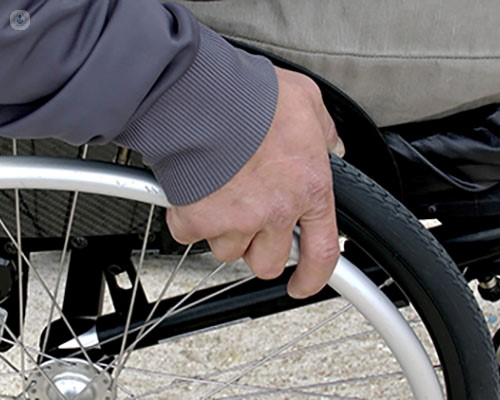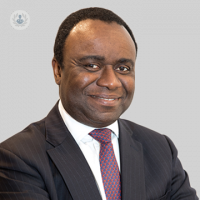Understanding neuromuscular scoliosis: Causes, symptoms, and treatments
Written by:In his latest online article, Mr Colin Nnadi gives us his insights into neuromuscular scoliosis. He talks about the causes, symptoms and signs, treatment options, how it can affect daily life and mobility and if there are any exercises or therapies that can help alleviate symptoms.

What are the causes of neuromuscular scoliosis?
Neuromuscular scoliosis, in essence, is a type of scoliosis often identified in patients with neurological disorders affecting muscles or nerves. These disorders may exhibit either progressive or non-progressive characteristics. Common instances include conditions like cerebral palsy, spinal bifida, and cases where children have experienced trauma at an early age, leading to the development of scoliosis. Additionally, tumors in the spine can contribute to the manifestation of neuromuscular scoliosis. It's a complex condition, with its progression influenced by a variety of neurological disorders.
What are the symptoms and signs of this disease?
Similar to the idiopathic scoliosis group, the initial indication in this context is the observation of a curvature, a task often taken on by caregivers, given the complex needs and learning difficulties often present in these children. Caregivers may detect this curvature through direct visual assessment or by noting symptoms such as the inability to maintain an upright posture in a wheelchair.
As these children are frequently wheelchair-bound or mobile for limited periods, a key concern arises when it becomes apparent that they struggle to sustain an upright position in the wheelchair. This, in turn, can have ramifications for their social interactions and overall well-being. Additionally, severe cases may lead to back pain, with the top of the pelvis potentially touching the rib cage, causing discomfort, skin irritation, and the development of pressure areas due to prolonged periods of leaning to one side.
As the deformity progresses, these children may experience recurrent chest infections, alterations in pelvic posture, and associated hip problems. Changes in pelvic posture, including tilting and rotation, can lead to secondary hip issues, causing pain and even discrepancies in limb length, making wheelchair comfort more challenging. Behavioral changes, such as increased irritability, frequent crying, or wincing during movement out of the wheelchair, become evident, resulting in a reduced quality of life for both the patient and their caregivers.
What are the treatment options available for managing neuromuscular scoliosis?
When considering treatment options, my recommendation is to start with simpler approaches. Initiating basic interventions such as physiotherapy aims to prevent contractures and maintain spinal flexibility. Additionally, modifying wheelchairs by enhancing support, especially the trans support, and even exploring the use of braces are viable options.
While a brace might not provide a long-term solution, it can serve as a temporary measure while awaiting surgery. If these straightforward measures prove ineffective, the discussion should then shift towards surgical intervention. It's important to note that surgery in these cases is intricate and places significant demands on patients. Therefore, careful consideration is crucial to ensure the success of the surgical procedure.
How does neuromuscular scoliosis affect daily life and mobility?
The impact of neuromuscular scoliosis on a child's life depends on how well it is managed. When well-controlled, many of these children can lead relatively normal lives within the framework of their neurological challenges. However, if the condition is poorly managed, it can significantly affect their overall quality of life.
One critical aspect is the ability to maintain an upright posture in a wheelchair. This difficulty can hinder their eye-to-eye contact with caregivers, which is crucial for social interaction. Despite facing complex needs and learning disabilities, these children still appreciate life and derive a sense of well-being from observing and feeling connected to their environment.
In cases where maintaining eye contact becomes challenging, and they experience frequent pain, recurrent chest infections leading to hospital visits, or the need for assisted ventilation due to breathing difficulties, their ability to lead normal lives within the context of their disabilities is further restricted. This can be distressing for both the children and their caregivers.
Are there any exercises or therapies that can help alleviate the symptoms?
Maintaining spinal flexibility can enhance the effectiveness of treatment methods such as wheelchair adjustments or bracing. However, the general trend among neuromuscular patients is that those confined to wheelchairs are more prone to developing progressive scoliosis, often leading to eventual surgery.
For a child with neuromuscular scoliosis who is still mobile, the goal should be to preserve their mobility for as long as possible. This is where interventions like physiotherapy play a crucial role. On the other hand, if a child already has a significant curve and is wheelchair-bound, the likelihood is that treatments like physiotherapy may not effectively halt the progression of the condition.
Mr Colin Nnadi is an adult and paediatric spinal deformity surgeon with more than 35 years of experience. You can schedule an appointment with Mr Nnadi on his Top Doctors profile.


